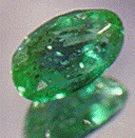
 Emerald
Emerald
The green variety of the mineral beryl, is the most famous and favored green gemstone. Its beautiful green color, combined with durability and rarity, make it one of the most valuable gemstones. Beryl also contains other, lesser known gem varieties, such aquamarine and heliodor. Pure beryl is white; emerald's green color is caused by chromium impurities(and occasionally by vanadium impurities). Deep green is the most desired color in emeralds. The paler the color of the emerald, the lesser its value. Pale emeralds are not called emeralds, but "green beryl". They are sometimes heat-treated, in which they become aquamarine.
Emeralds are notorious for their flaws. Flawless stones are very uncommon, and are noted for their great value. Some people actually prefer an emerald with very minute flaws over a flawless emerald, as this proves authenticity of the stone. Many emerald flaws can be hidden by treating the emeralds with oil. Newer, more effective fracture-filling techniques are also practiced. Irradiation of some emerald gems is somewhat effective in removing certain flaws.
Many emerald fakes and doublets are known. Two pale colored stones may be glued together with deep green paste, creating a stone resembling emerald. Faceted green glass also resembles emerald, and it may be coated with a hard substance to mask its low hardness. Synthetic emeralds are also sold to unwary buyers without them knowing the stone is synthetic. Experts can distinguish all these fakes, and it is especially important to only purchase emeralds from reliable dealers. Experts can also determine if an emerald was treated with oil to mask internal flaws. Generally, unless otherwise specified, it can be assumed that an emerald has been treated with oil.
A rare, prized form of emerald, found only in the Muzo mining district of Colombia, is a very unusual form of this gem. This emerald, known as Trapiche emerald is characterized by star-shaped rays that emanate from its center in a hexagonal pattern. These rays appear much like asterism, but, unlike asterism, they are not caused by light reflection from tiny parallel inclusions, but by black carbon impurities that happen to form in the same pattern.
Emerald may develop internal cracks if banged hard or if subject to extreme temperature change. Emeralds that were treated to mask internal flaws should never be cleaned with an ultrasonic jewelry cleaner, nor should they be washed with soap. These practices will remove the oil and expose the hidden internal flaws.
Transparent emeralds are faceted in gem cuts for jewelry, and translucent material is cut and polished into cabochons and beads. Trapiche emeralds are also cut into cabochons, making exquisite jewelry pieces. A very small number of emeralds display asterism and chatoyancy. These too are cut into cabochons.
Emerald is very sensitive to knocks, and the famous emerald cut was developed specifically for this gem to reduce the amount of pressure during cutting.

Emerald is the birthstone of May.
More Emerald Lore
The Moguls of India, including Shah Jahan, the builder of the Taj Mahal, loved emeralds so much they inscribed them with sacred text and wore them as talismans. Some of these sacred stones, called Mogul emeralds, can still be seen in museums and collections today. For example, one talismanic emerald is deep green and weighs 78 carats. Around the edge in Persian runs the inscription: "He who possesses this charm shall enjoy the special protection of God."
According to legend, Emeralds strengthen the owner's memory, quicken the intelligence and assist in predicting the future.